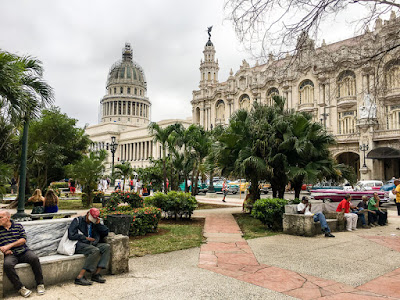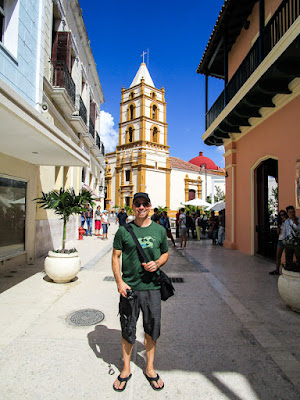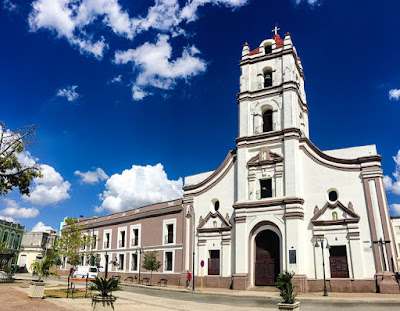
We didn't realize it, but we would be standing in a lot of lines in Cuba. Here’s the bank where we exchanged money for Cuban Convertible Currency (CUC). CUCs are tied to the value of the US dollar and are used by tourists in Cuba.

Then we needed an Internet card, so we stood in line for 3 hours to buy one. We look pretty cheerful because while we waited we talked with an English couple who also love to travel.

Internet access is only offered in the larger squares and plazas of Cuba. Provided by a government-run company, we found service to be spotty and slow at best, and at worst non-existent. Pete is checking email and our Twitter feed.

Pete is enjoying his first mojito. The Cuban rum is very good! You may be wondering how is it that we Americans can travel in Cuba? It’s because President Obama relaxed the travel and economic restrictions against Cuba, and our trip meets one of 12 allowable categories of travel: a person-to-person cultural tour. Here’s to Obama! We miss his ethics and integrity!

We quickly realized that the best way to experience Cuban culture was to walk around. On the left is the old capital building and on the right is the Gran Teatro de la Habana.

We saw plenty of Cuban flags as we started exploring.

Much of Havana's colonial architecture is in terrible shape but still manages to be quite beautiful. We saw laundry drying in a building that hardly looked inhabitable. The Cuban people, however, seem to take it in stride and are incredibly resourceful.

After the colonial architecture, the old 1950s American cars are the next amazing sight. This Chevy was near La Floridita, allegedly where the first daiquiri was invented.

We saw by comparison how the United States has a disposable culture, ready to throw things away, because we can afford to and because there’s always a newer version available. In Havana there are thousands of cars more than 50 years old that are kept running and are a great source of personal pride. The classic cars are represented in paintings and other souvenirs as a symbol of the city.

Every day we saw kids playing in the parks and squares. Kids seem to have a lot of freedom and we felt very safe.

The Malecón is a wide boardwalk area near the sea where lots of locals hang out and stroll.

Musicians are everywhere in Cuba. We stopped to listen to this talented trio.

We enjoyed the colors of the sky at sunset. Behind Kristina is the newer downtown of Havana called Vedado.

Che Guevara is memorialized on countless buildings and walls. Originally from Argentina, Guevara joined the Cuban Revolution as a doctor-turned-guerrila after observing US imperialism throughout Latin America.

Guevara was a brilliant strategist and leader who was critical in bringing socialism to Cuba. Che is on the three peso bill. In addition to CUCs, there are also Cuban pesos in circulation, which are used by the Cuban people. For comparison, three pesos is worth about seven US cents.

Camilo Cienfuegos, another National Hero of the Cuban Revolution, is on the 20 peso bill.

We visited the Revolutionary Square, the seat of government of socialist Cuba. This building has Camilo Cienfuegos on it. Although Cienfuegos died in a plane crash shortly after the revolution, he was a key military leader during the guerrilla war and early in the Cuban socialist government.

We traveled by bus to Camagüey. Camagüey is the third largest city in Cuba, and we found it lively with people walking around. This is the front door of our casa paticular, a Cuban style bed-and-breakfast hotel.

Staying in a privately-owned casa particular was a great way to spend time with Cubans and to learn about their lives. Our hosts from left are mom Anaeli, daughter Laura and her grandfather, a happy family.

The five of us had dinner together. Laura requested fried plantains and her grandfather was happy to oblige.

Walking around Camagüey we noticed that the colors here seem muted compared to Havana.

This woman was selling cookies and membrillo de guava in front of her house.

We explored the historic part of Camagüey, noticing the faded paint and deteriorating walls.

Only the walls and arches remained of this building.

Artwork reminiscent of Portuguese artist Alexandre Farto (who tags his carved public art pieces Vhils) had been carved into the stucco and bricks. Our host Anaeli helped to identify the portraits as (left to right) Carlos Manuel de Céspedes, Julio Antonio Mella and Maximo Gomez, who are all modern political figures in Cuba.

Originally founded in 1528, legend has it Camagüey built its streets to be curvy and irregular in order to confuse potential bandits. We saw slogans celebrating Fidel Castro at this unusual intersection.

This is the city crest of Camagüey in terrazzo. It was on a pedestrian street called el Bulevard.

Nearby people were lined up at a shop selling milk products. Cuba still has food and goods shortages, and it seems word gets around quickly when a shop has scarce items available. The pace of life in Cuba seems laid back and people often need to stand in queues.

Cubans love ice-cream, so we were able to sample a few different flavors. Pete has a scoop of chocolate on a cone which cost $.50.

Kristina has coconut and chocolate soft-serve. They top their cones with whipped cream, chocolate sauce and a cookie.

When buildings have been renovated often they are ornate and lovely, like this hotel.

Santa Cecilia is now a cultural center.

Camagüey has 15 churches, the most per capita of any city in Cuba. Behind Pete is Iglesia de Nuestro Señora de la Merced, which was built in 1748.

Iglesia de Nuestro Señora de la Soledad is a massive Baroque structure from 18th century that has been recently renovated.

Here's a photo of Catalan Gothic style Iglesia de Nuestra Corazón de Sagrado Jesús. Unfortunately all the churches in Camagüey were closed, so we just enjoyed the exteriors.

In the background you can see the top of Iglesia de San Cristo de Buen Viaje, with the sprawling Necropolis in front.

In Plaza Agramonte is an impressive statue of Ignacio Agramonte on horse back. Agramonte was a 19th century revolutionary. To the right is Cathedral de Nuestra Senora de la Candelaria, the holiest church in Camagüey.

This is Plaza Carmen with Iglesia de Nuestra Señora del Carmen. The square also has wonderful bronze sculptures by Martha Jiménez.

This is Roberto next to a Jiménez statue made in his image. We figured out that he earns his living by posing next to the statue. Cubans are very resourceful about making money!

Pete is in front of the Martha Jiménez gallery.

We liked her paintings with their bright colors and strong, free women.

In the courtyard of the gallery was this irreverent fountain.

Yes, it’s a fountain of a woman crouching to pee!

We also spotted artwork by Ileana on walls in the city. We visited her studio too.

We liked seeing the cheerful ducks and cats riding bikes and playing music.

But the paintings could stand to be restored.

The classic cars are less common in Camagüey than in Havana, but they are still around.

Here’s Pete with our taxi driver Pedro and his 1958 Chevrolet. Pedro has on a California t-shirt. He and other Cubans welcomed us when they learned we are from California, and said they are starting to have more visitors from the US.

We traveled by bus around Cuba. We spent one night in Sancti Spíritus to break up our travel time. Luckily we arrived in time to go inside the library.

Pete is in the stairwell, heading up to check out the views. Some of the coolest accomplishments of the socialist revolution involve literacy, and thousands of army barracks were turned into schools and beautiful buildings like this one became libraries.

From the library balconies we could see Jose Martí square lined with colorful colonial era buildings.

We could also see Iglesia Parroquial of Sancti Spíritus.

It was built in 1618.

We were happy that the church was open so we could look at the inside too.

We took a bus to Trinidad. The bus stopped so the driver and crew could take a lunch break, and there was live music at the rest stop. How great!

Kristina is next to Maytta, the owner of our next casa particular. Maytta was very welcoming and we enjoyed staying in her home.

There were always a lot of people around Maytta’s, and the house was filled with friendly chatter. Here are two women with clean laundry to hang up.

This is Maytta’s granddaughter. She was really cute but a bit shy, so she kept her eye on us while she sat on the swing.

We had breakfast in the covered patio each morning.

This gave us a chance to talk to Maytta’s pet parrot named Lola. It seems her favorite phrase is “arriba!”, which was fitting since she liked to perch above the courtyard and look down on us.

Trinidad is a UNESCO World Heritage Site. Like much of Cuba, being in Trinidad's historic center felt like stepping back in time. Notice how the streets made of irregular size rocks. Yes, it is hard to walk on them!

The sign above Kristina says la canchánchara, which is a tasty “medicinal” drink of rum, lemon and honey.

We saw a few classic cars in Trinidad too.

This photo is a collection of four different windows and doors. Trinidad is so colorful.

We went to Museo Histórico Municipal and climbed up to the top of the tower. The views were wonderful! Behind us is Iglesia de la Santísima Trinidad in the Plaza Mayor.

We were able to go inside Iglesia de la Santísima and found the woodwork and white walls quite beautiful.

Also from the Museo Histórico Municipal tower is a view of San Francisco de Asis, a former monastery.

Here’s how it looks lit up at night.

These days San Francisco de Asis is a museum about the Cuban socialist revolution.

We were able to climb the tower, and loved how the round windows framed the views of Trinidad.

The bells in the tower are ceramic.

Here’s a panorama that shows the view from the top. The ocean is just a few kilometers away and we could feel its cooling breeze.

In the square across the street from San Francisco de Asis we listened to a local group.

Talented musicians abound in Cuba. This is Grupo Los Pinos playing for tips in the street.

Music is such an important part of Cuban culture. We spotted these youngsters in a dance class.

Another important cultural aspect is the quinceañera, a girl’s 15th birthday, which is celebrated with a big party and professional photography session.

We are honoring Bill Cunningham, New York Times fashion photographer and creator of On The Street column who passed away last year, with this collection of Cuban fashion photos. We’re seeing a lot of American flag clothing.

Very popular with the women are black patterned fishnet stockings.

We noticed people dressed all white, including white fishnet stockings and were intrigued. We even saw children dressed all in white. We wondered if they were practicing the Santería religion.

So we went to Casa Templo de Santería Yemallá to learn more about the Santería religion.

Located in the priest's home, he was lighting candles on the Yemallá altar as we arrived. The altar is dedicated to Orisha, the Yoruba god of the sea.

The priest shared photos with us, including this one of him releasing a white dove in a ceremony.

Slaves in Cuba added Catholic themes to their west African Yoruba mythology so they could still practice their religion.

This table was filled with water, in bowls, in vases and in glasses.

We took the bus to Havana and it felt familiar to be back in the city. The Cuban people are so friendly. This girl wanted to have her picture taken with Kristina.

We walked through Havana University campus.

Here are some colorful neighborhood photos.


We spotted this bicycle that just needed a rear wheel and a really long chain.

Inside the door above the Cuban flag it says “somos Cuba”, we are Cuba. It was such an interesting building with its facade layered in peeling paint.

We spent time in centro historico. This 1906 building is still so elegant, and the fact that there are only these delicate walls that makes it even more wonderful. The crane overhead implies it’s being restored.

Here Kristina is mailing postcards to our Moms.

In Plaza de la Catedral is La Catedral de la Virgen María de la Concepción Inmaculada from the 1770s.

Kristina is at this fountain that still had lions spitting water.

And in the midst of all these colonial era buildings are a few modern sculptures like Etienne’s 2012 la conversación, making Cuba feel timeless.

We visited museo de la revolución to learn more about Cuban socialism.

Led by Fidel Castro and others, the revolutionary movement started on July 26th, 1953, with an attack on a garrison in Santiago, Cuba. The July 26th date is immortalized throughout Cuba because the revolutionaries took the name 26 de Julio for their struggle.

The 26 de Julio group was tried by the Bautista government and they spent a year in jail. (Perhaps you have heard of History will Absolve Me, a book written by Castro with his defense.) While exiled in Mexico, the group grew to be 82 guerrillas who obtained a boat and returned to Cuba to launch the revolution. This was their uniform.

Kristina is in front of Arca de Libertad, a recent collaboration of 10 artists depicting the boat and revolution.

We walked along the Malecón, enjoying the views and people watching.


We saw a few cyclists.

And plenty of classic cars.


Here’s a group of cars that we especially liked.

Towards dusk we took a rest in a park. Cuba is very tranquil, and we felt very relaxed here.

We enjoyed the lights coming on in the historic buildings.

And finally called it a night after seeing the gorgeous theater of Havana lit up.

Our next blog will be about our Cuba cycling trip.
